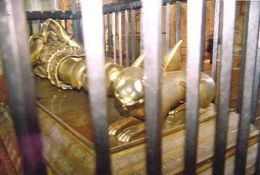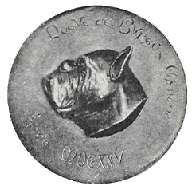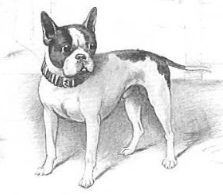 |
 |
 |
|
 |
|
|
Chincha Bulldog Head Chimu Figure, c. 1200 AD |
The Chincha Bulldog “On the basis of all artwork and skeletal finds, this Indian dog [the Chincha Bulldog] in ancient Peru resembles the French Bulldog to a striking degree” wrote Dr Dieter Fleig in his Fighting Dog Breeds (TFH 1996). In 1937 Professor Richard N. Wagner and Max Hilzheimer studied Peruvian mumified dogs and excavated skeletons. They found that the Chincha Bulldog’s skull had many similarities to the skull and anatomy of the French Bulldog. Excavations of the burial grounds of Ancon in central Peru of mumified bodies of dogs, skulls and skeletons confirmed that bulldog-like dogs lived in Peru from 1100 to 1400 AD. About the only difference the scientists could find was that the cranium of the Chincha Bulldog was pear shaped, not spherical like the frenchie. |
The Black Prince’s Small Dog“Tomb of Edward Black Prince, Canterbury Cathedral showing French Bull Dog at feet”. This is the title to a picture in a book described by the late and eminent Clifford Hubbard as the last great dog book (The Book of the Dog ed Brian Vesey-Fitgerald Nicholson & Watson 1948). Edward III the Black Prince was born in 1330 and died in 1376. Research has not been able to find out anything about the small dog. It is somewhat similar to a frenchie but most unusual, with a short muzzle and small rounded ears. However the eyes are almond and there is a rather long tail. |
|
|
The Dogue de Bordeaux and the FrenchieA 1625 bronzed plaque was discovered which showed the head of a dog and the inscription “Dogue de Burgos Espana”. [Burgos was the principal town of old Castile in Spain.] This was the main basis for the argument that these dogs migrated to France and “they bantamised the breed to the modern toy bulldog” (George R. Krehl London Stockkeeper 1900). Charlton Jemmett Browne, a substantial French bulldog authority, wrote in The French Bulldog in February 1913 (vol 1 no 2 p 28) “The idea that the French bull dog originates from the Spanish bull dog is ridiculous in my opinion, for the principal point that these dogs gave to their progeny when crossed with the English bull dogs was size.“ In 1926 it was stated “The illustration, herein presented, of the Dogue de Bordeaux ought to be sufficient to make absurd any claim that could be advanced that this type of dog could have had any part in the creation of the French Bulldog. They were first of all unusually large, weighing upwards of a hundred pounds … “ (O.F. Vedder in The French Bulldog FBCA & FBC of New England 1926). |
Toy or Miniature Bulldogs Because of the industrial revolution, from about 1850 to 1860 the English textile and clothing industries were in turmoil. Cottage industries in the English Midlands were being abandoned. The lacemakers of Nottingham who worked by hand no longer had jobs. Many of these lacemakers migrated to the coastal towns of Normandy and in particular to Brittany and Calais where the old traditional work continued. Nottingham was a great centre for British Bulldogs including the toy or miniature bulldogs. Many of these small dogs were taken to France by these workmen because of the dogs’ size, companionship and because they were good ratters. (Living conditions were cramped in the small houses in which workers lived.) Nottingham was a great centre for British Bulldogs including the toy or miniature bulldogs. Many of these small dogs were taken to France by these workmen because of the dogs’ size, companionship and because they were good ratters. (Living conditions were cramped in the small houses in which workers lived.) The miniature bulldogs are thought to have been crossed with terriers and pugs and the French Bulldog evolved. Lack of records frustrated the researches of breed historians and it seems unlikely that more will emerge. |
Nottingham Frank - Toy Bulldog whelped circa. 1849
|







